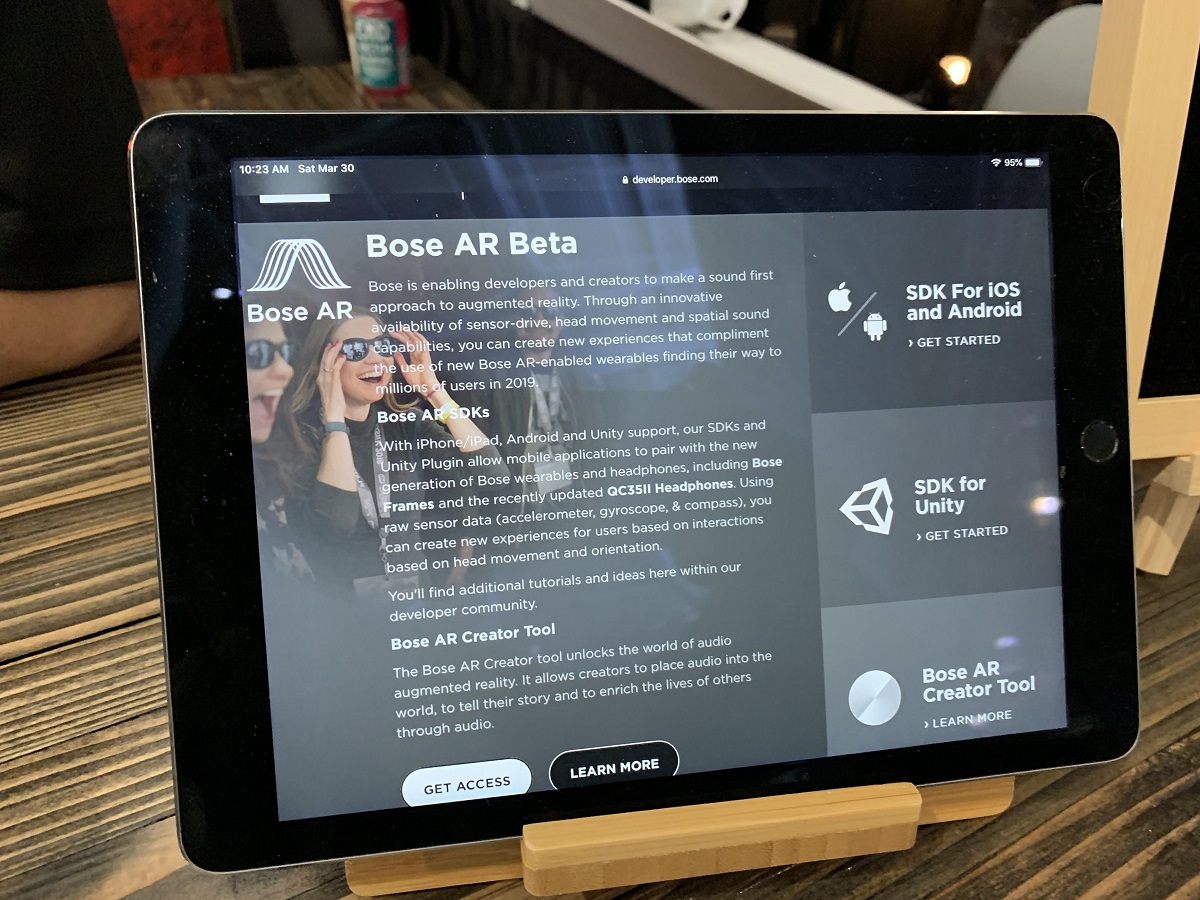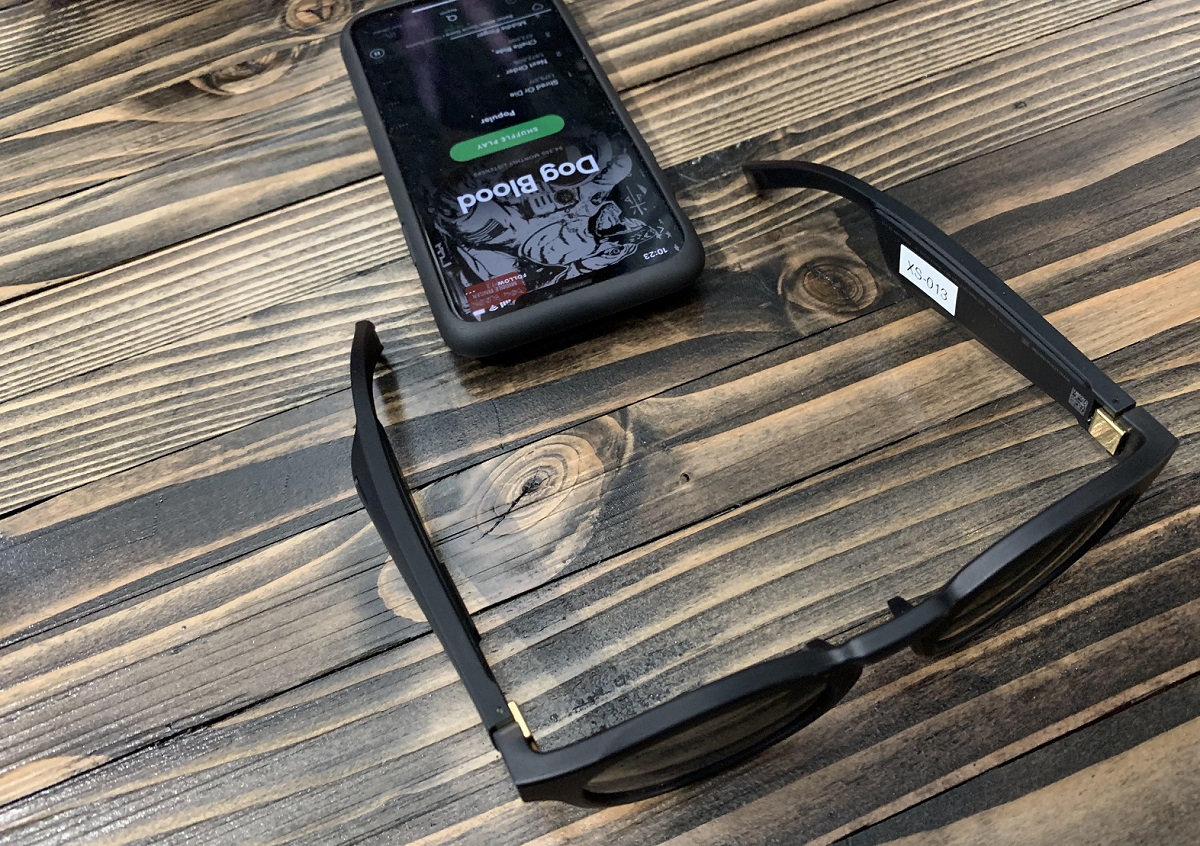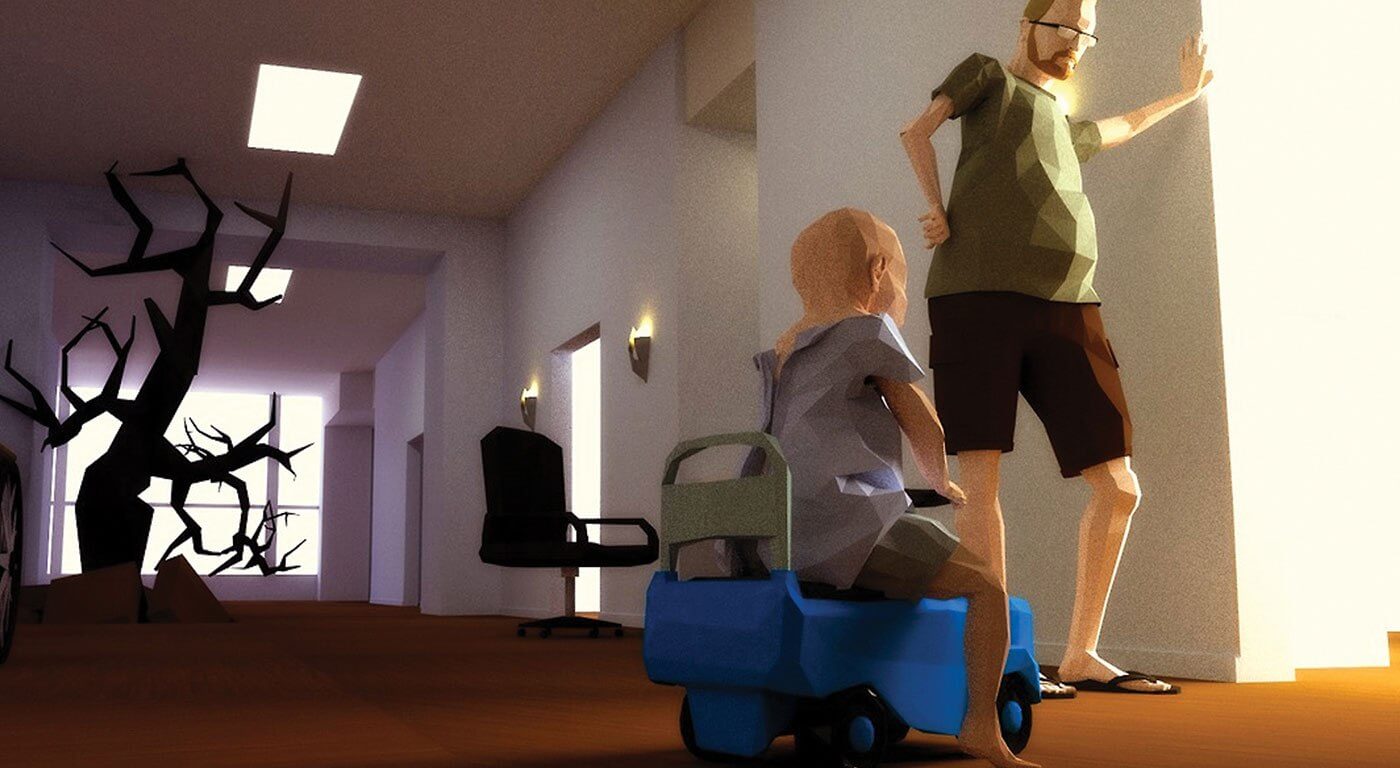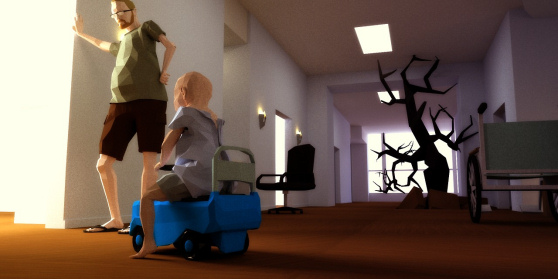The most recent game from the team behind the emotionally evocative and autobiographical That Dragon, Cancer was built for a pair of sunglasses.
In The Other, players wear Bose AR Frames — head- and gesture-tracking sunglasses with built-in speakers — as they listen, look, and walk their way through a narrative game set in a dystopian future.
“The Other takes place in a fictional authoritarian dystopian city-state,” the developers at Numinous Games told GamesBeat in a group email interview. “A cultural revolution has mandated that those deemed ‘the other’ be rounded up and forced to conform under threat of death. Vigilante mobs dedicated to this cleansing roam the streets to enforce cultural conformity. You as the player are an “other” who has been offered safe passage out by a smuggler. Can you work together to avoid the mobs and escape the city?”
“This audio-only adventure game acts as an allegory for the ideological division in contemporary American society. We think it’s important to continuously ask ourselves the kinds of questions that shape who we are as a people in this country. We’ve been given tremendous liberty in this country, who should we extend those freedoms to? When and how should we risk our own freedom for others when see injustice around us? And, finally, can we do better?”
The team said they learned from their work on That Dragon, Cancer, that it’s more interesting to wrestle with the answer to the questions they ask they to presume they already know the answer.
While the story explores important, timely issues, it’s how players interact with the game that genuinely sets it apart.
Loaded on a phone, The Other uses the tech built into Bose audio AR sunglasses to detect which direction they are looking. It uses that information to track their movements through a simulated city spread across 20 virtual blocks and built using a 3D spatial soundscape. Players never see anything from the game; their phones can remain comfortable in a pocket or bag. Instead, they need to use spatial sound to avoid the dangerous mobs that roam the city by following in-ear navigation cues and the guidance of a mysterious smuggler.

Above: Bose Frames
The Other is out on Android, with a few issues that the team is still working to fix. The hope, Numinous said, is to add more stories to the game as well.
“It would be great to not only explore the limits of the technology Bose has made available to us with incredible audio fidelity, 3D spatialization, head gestures, and three degrees-of-freedom head tracking, but also explore more storylines in the dystopian future we hope never comes to pass.”
The Other is just one of 30 or so games either already released or in development for the Bose-powered sunglasses and a special pair of AR-enabled headphones, and Bose sees this blossoming of audio-centric experiences as just the start of a new sort of Bose experience.
Southern showcase
The idea of embedded six high-end, finely tuned miniature speakers in a pair of sunglasses that could also track head movement came out of Bose’s desire to broaden its approach to sound.
“Premium sound is what we’re known for, but we’ve been thinking about what else we can do to help deliver value and new experiences to users,” said Chuck Freedman, who’s part of Bose’s developer relations team.
In 2018, Bose rolled out the prototype for Bose AR sunglasses at SXSW to “evaluate” the consumer and developer response, Freedman said.
“We wanted to see if these new kinds of devices — which had some level of sensors in them to inform the app where the user was headed, what direction they were looking, that could detect a range of movement — could help developers and creators deliver some more value,” he said.
“The feedback was extremely positive, and we decided to build out a platform and offer tools in terms of a software development kit and plug-in.”

Above: Bose AR’s in beta on an iPad.
The new sort of experience was named audio augmented reality — or audio AR and Bose set about figuring out how best to make use of it. The idea, Freedman said, was to deliver new experiences with a “sound-first approach.”
The first devices to use the new tech were two pairs of sunglasses. The Frames, as Bose called them, both feature three tiny speakers built into each arm of the sunglasses as well as a single, small button and sensors that can detect movement and which way a person is facing.
“The feedback was tremendous,” he said.
The Frames use an open ear concept that allows a person to hear their surroundings, but also the music they’re listening to through the glasses. Couple that with audio tied to head movement, gestures, and location and the experience is surprisingly powerful.

Above: Bose AR glasses work with Spotify, too.
Early demonstrations tied special navigations apps to the Frames, allowing users to look at a location, tap the button and hear something about it.
That initial response, Freedman said, was positive on two fronts: Users loved the way the audio was delivered and the quality of the sound, but they also liked the idea that the Frames could be used with apps that provided more features.
Perhaps more important, Bose heard from a number of developers and creators that they were interested in building apps for the device.
It was that level of interest that propelled Bose to launch a funding program.
Playcraftin’ jam
As part of the initiative to fuel development of apps and games for Bose AR, the company also reached out to Dan Butchko, who runs New York-based Playcrafting. The community-driven gaming meetup group started in 2009 and has since grown to host more than 100 events and classes across the country, partnering with the likes of Bose, Verizon, the NFL, and IBM.
The pairing opened the door for Playcrafting to hunt for developers interested in creating for the platform and empower them.
“We directly connected Bose with developers from across the country,” Butchko said. “We set up this scenario where we do game jams with folks from the community and Bose comes on-site to do a quick workshop.”
Those game jams, in turn, spurred development of about 30 others from developers in five cities. As the games become playable, they are then shown off at Bose AR Arcade events in places like the PAX East and PAX West fan conventions.
Those currently in development games come from a wide range of game makers — like Numinous Games — and include an eclectic variety of games. In one, “Hide and Bose Seek,” a Frames wearing seeker finds hiding players in the real world by following sound pumped through the sunglasses’ speakers. When the seeker looks in the direction of a hiding player, the sunglasses plays music. The closer they get, the louder the music.
Non-gaming apps also offer engaging experiences and flashes of genuinely surprising moments.
Bose own “Radar” app includes several audio experiments, including an AR-powered tour of the Sunset Strip which only works in Los Angeles and soundscapes that seem to drop users in the middle of different locations. In one, users hear the sounds of a packed beach in summer. The sound of waves crashing ashore mingle with people talking and children playing. Above, a plane drones by. As you look around, the sounds stay in place. So if you turn to the left, the sounds of the ocean — which was in front of you — now sound like it’s to your right. Look up at the plane, and the sounds become louder. Positional 3D audio isn’t new, but when tied to head movements and those six open-ear speakers, the experience catches most people by surprise.
“Through our alliance with Playcrafting, we’ve engaged over 25 teams and 100 game developers, artists, and even musicians, innovating with Bose AR,” Freedman said. “Meeting these teams at code jams and events, we’ve seen amazing games exploring many exciting possibilities with our audio augmented reality platform. Developers have embraced the challenge of designing and building sound-first gameplay. We expect to see most teams launch their mobile games in the coming months on the Apple app store and Google Play.”
That also includes existing apps that are adding Bose AR support. For instance, “Golfshot” recently relaunched with new Bose AR-enhanced features on iOS and Android, which allows users to find the green through audio cues while wearing the Bose Frames. Bose also recently teamed up with Capitol Records to roll out a new creator tool to help streamline developing audio experiences for Bose’s Radar app.
These sorts of releases are precisely what Bose was hoping for when they rolled out the tech last year.
“Bose AR continues to be at the center of our developer relations efforts, and has helped us not just attract incredible people to our community, but also to our amazing team,” Freedman said. “We’re fortunate to be engaging a community of developer and creators interested in audio augmented reality. Independent professionals, teams, brands, and innovative companies are using Bose AR to enhance their own apps while bringing new experiences to our wearable users.”
And it’s gaming that continues to help showcase the range of what’s possible with Bose AR.
“In addition to other compelling apps and experiences available to our users, we continued to recognize gaming as some of the most available and enjoyable apps in our ecosystem,”
Freedman said.
That Dragon, Cancer

Above: The haunting imagery of That Dragon, Cancer.
The power of the human voice, a lesson learned through That Dragon, Cancer was what drew Numinous to Bose AR project.
“Working on a game like That Dragon, Cancer changes you,” they said. “No one on the team could think about video games the same way again. It was then that we discovered the power of the human voice. We saw the value in elevating the quiet voices who may not get enough of a chance to speak. And we also saw the value in the sound of the human voice itself.
“Because of that perspective, we’ve tossed around ideas for audio-only games and interactive experiences at Numinous for a while now. And when (Indie Megabooth founder) Kelly Wallick graciously told us about the Bose AR Jam, we jumped at the chance. The technology Bose is developing in their new flagship AR-powered products really takes audio-only game experiences to the next level. Audio-only experiences not only provide a new level of accessibility, but thanks to the new 3D spatialized audio solutions available today, they also add a new level of immersion and control that can ignite a players imagination.”
Now that they’ve created their first game for Bose AR, Numinous calls the technology incredible.
“Having spatial awareness through sound is something that is crucially important for any immersive game and storytelling experience,” they said. “The ability to track three axes of movement of the listeners head make the possibilities for audio-only games very exciting.
“This technology represents another facet of the immersive computing revolution. Designers in this space are already inventing entirely new haptic languages of interaction. We’ve seen incredible advances in the languages of touch, gesture, and visual user interface with mobile, VR and AR, but game middleware and platforms are only just now catching up on the language of audio as interface and input. Our experience using speech recognition as input has taught us there’s so much potential there.
“We think the future is bright for audio-based AR as long as the platforms are willing to partner with and empower developers to innovate.”

